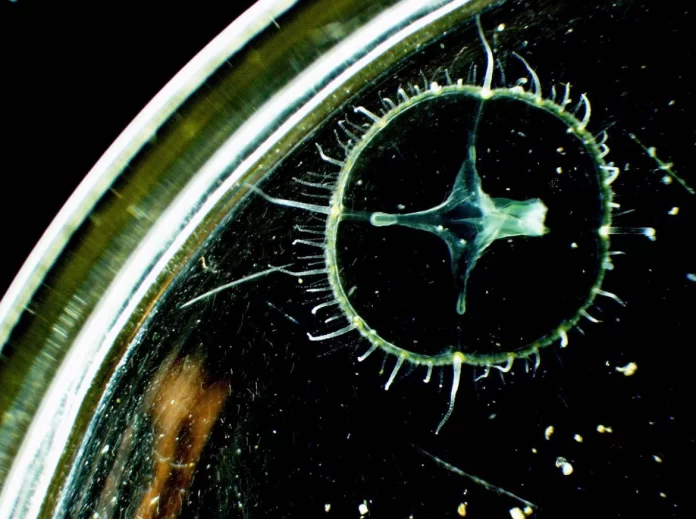They’re back — the jelly inhabitants of the Crim Dell have made a return this year, with an earlier bloom resulting in visible jellyfish gliding around the water.
These jellyfish are Craspedacusta sowerbii, the only freshwater jellyfish we know of on earth. These jellyfish reproduce asexually, and their polyps, which is the beginning stage in a jelly’s life, attach to sticks and rocks, which makes them easy to spread to other waterways.
According to the Smithsonian Environmental Research Center, the jellyfish “is believed to be native to the Yangtze Valley, China.”
Craspedacusta sowerbii are found all over the world in ponds and lakes. Some of them are around a few hundred meters from the Allen Marine Invertebrate Biology lab.
Savara Shrivastava ’27, an undergraduate researcher in associate professor of Biology Jon Allen’s marine invertebrate biology lab discussed the irregularity of their appearance on campus.
The Crim Dell jellyfish have no pattern of showing up year after year. Last year, there was no sign of them swimming around, as there was no bloom at all.
“Because we are in a bloom stage and the blooms don’t happen all that often, we try to collect as much data as we can, so we’ve been out on the kayaks for the past week almost every day,” Shrivastava said. “Essentially what we are doing right now is a lot of field-based sampling.”
Having the Crim Dell and Craspedacusta sowerbii at the fingertips of researchers is an incredible opportunity to learn more about these organisms.
As far as it’s known, there is no direct correlation between blooms and relative rainfall, acidity levels, differences in temperature, amount of fish or turtles in the water or any other external stimuli. Shrivastava called this the big mystery.
There is no regularity to these blooms of jellyfish, as they can be small blooms or big blooms, and there is still uncertainty as to what causes the difference in amount.
What is notable, however, is that this year’s bloom can be compared directly to last year’s lack of bloom. This means researchers can look at the ecological conditions then and now to see what changed to cause the bloom.
Shrivastava mentioned how important Allen’s guidance was while working in the Allen marine invertebrate biology lab.
“It’s a both hands-on and hands-off approach simultaneously of ‘I’m not going to control everything you do,’ but I’m also going to help make sure you’re not off doing something that’s not going to be super productive or super helpful because there’s already scientific literature about it,’” Shrivastava said.
Allen gave insights into possible reasons as to why the jellies are so irregular.
With more diverse types of projects, Allen said, more students have more opportunities to study biology in general, and focus on specific projects and specific organisms.
“It’s also the kind of thing where it was driven by students. So it wasn’t something where I was like, I really want to work on freshwater jellyfish. But students at William and Mary and going back several years now have found them fascinating. I think that’s pretty cool,” Allen said.
The data acquired from doing tows throughout the Crim Dell during a bloom is beneficial not only to the study of the jellies, but even when there is no bloom.
With or without the jellyfish floating around in the water, the lab still studies the polyp forms to learn more about that stage of life.
The amount of jellyfish in a bloom is not guaranteed, but usually it is somewhere in the thousands. This year, there were thousands of jellies, Allen said. That could be in the range of tens or hundreds, but the lab is still discovering that and hoping to start to identify what role the jellies play in the environment.
“I have low confidence,” Allen said, referring to hypotheses about the jellyfish’s blooming cycles.
“Certainly it seems to be temperature-related, in terms of triggering the bloom,” Allen added. “What it seems to me is that it must be — I don’t think it can be ‘Well, it gets hot in the summer,’” Allen added. “Like that’s not enough because it gets hot every summer here. So it has to be temperature in conjunction with some other factor.”

